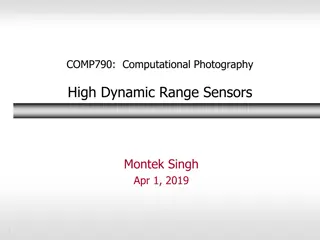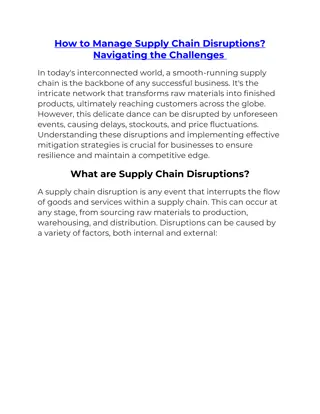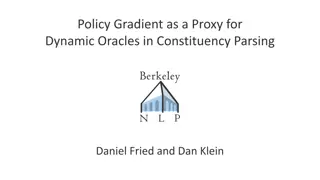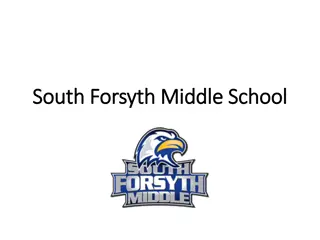Exploring Kineograph: Navigating a Dynamic and Interconnected World
Dive into the realm of Kineograph, a system designed to handle real-time data in a fast-changing world. This technology focuses on analyzing dynamic graphs and computing global properties in an ever-evolving network. Discover its applications, challenges, and innovative features showcased through various examples and illustrations.
Download Presentation

Please find below an Image/Link to download the presentation.
The content on the website is provided AS IS for your information and personal use only. It may not be sold, licensed, or shared on other websites without obtaining consent from the author. Download presentation by click this link. If you encounter any issues during the download, it is possible that the publisher has removed the file from their server.
E N D
Presentation Transcript
Kineograph: Taking the Pulse of a Fast-Changing and Connected World Raymond Cheng, Ji Hong, Aapo Kyrola, Youshan Miao, Xuetian Weng, Ming Wu, Fan Yang, Lidong Zhou, Feng Zhao, Enhong Chen University of Washington Microsoft Research Asia Carnegie Mellon University University of Science and Technology of China Fudan University Peking University 1/16
It is the Age of Real-Time Data Departure from traditional static web pages New time-sensitive data is generated continuously Rich connections between entities Goal: Compute Global Properties on the Changing Graph 2/16
Example: Mention Graph You should see this @bob @carol Alice: Alice 1 2 3 Bob Carol 3/16
Example: User Ranking over Mention Graph Influence Ranking Rank Twitter Handle 1 justinbieber 2 addthis 3 foursquare! 4 ladygaga 5 kanyewest Timeliness 4/16 t
System Challenges High rate of graph updates Consistent graph structure Static graph mining algorithms Timely results reflecting graph updates Fault tolerant 5/16
File:Linnet kineograph 1886.jpg Kineograph Scalable and fault-tolerant system for nearline graph mining Built-in support for incremental computation Kineograph API Examples: InfluenceRank Approximate all-pairs shortest paths K-exposure Epoch Commit Protocol Separation of graph construction from graph computation Zeitgenossische Illustration (1886) 6/16
Graph Update / Compute Pipeline Multiple data sources Serializable order of graph operations Tweet Transaction of graph operations Limitation: No cross-partition dependencies Snapshot consistency Atomic transactions Consensus on set of updates and ordering between snapshots Incoming Tweets Time Snapshot Construction Si-1 Si Si+1 Epoch Ci Graph Computation ti-1 ti ti ti Timeliness 7/16
System Overview Master Progress table Continuous Data feeds Ingest nodes Snapshooter Graph nodes Global consistent snapshots Graph Storage Computation Incremental computation on a static graph snapshot 8/16
Epoch Commit Progress table 0 1 2 3 s1 Global tx vector sn 3 4 7 Ingest nodes sn s1 Snapshooter No locking mechanisms required for global order Defer ordering decisions to master snapshooter Partition u Partition v s1 1 2 4 s1 2 3 5 Epoch specified by progress table and snapshooter Graph nodes sn sn 4 6 7 5 6 8 9/16
Incremental Graph Computation Updates from other vertices N Detect Vertex Status Compute New Vertex Values Change Significantly? Init Y Graph-Scale Aggregation Propagate Updates 10/16
Programming with Kineograph UpdateInfluence (v) { //event handling callback for a vertex val newRank = (1+p*v[ influence"]) / v.numOutEdges() foreach(e in vertex.outEdges()) { val oldRank = v.( influence", e.target) val delta = newRank - oldRank if (|delta| > threshold) v.pushDeltaTo( influence", e.target, delta) } //pushDeltaTo propagates changes to other vertices } //UpdateInfluence() triggered at changed vertices only 11/16
Evaluation System implementation Platform LoC: 16K~ C# 3 Apps LoC: 1.5K~ C# (Influence Rank, approximate all- pair shortest path, hashtag-histogram) 40+ servers, 1-week Tweets (~100M tweets) Key performance numbers Graph update rate: up to 180K tweets/s, 20+ times more than Twitter peak record (Oct.2011) Influence Rank average timeliness over 8M vertices, 29M edges: ~2.5 minute 12/16
Graph Update Throughput 200000 K-Exposure TunkRank SP 2PL 150000 125000 200000 K-Exposure Influence Throughput (tweets/s) 175000 175000 Throughput (tweets per second) SP 150000 2PL 125000 100000 100000 75000 75000 50000 50000 25000 25000 0 8 8 2 2 16 16 4 4 Number of ingest nodes Number of Ingest Nodes 13/16
Incremental vs. Non-Incremental Computation 400 360 Non-Incremental Non-Incremental Incremental Incremental Average Timeliness (s) 320 Average timeliness (sec.) 280 240 200 160 120 80 40 0 K-Exposure K-Exposure TunkRank Applicaiton Application SP SP Influence 14/16
Failure Recovery Throughput (ktps Timeliness (s) 100 Throughput 80 60 40 20 0 200 250 300 350 400 450 500 550 600 120 t1 Timeliness 100 80 60 t0 40 20 0 200 250 300 350 400 450 500 550 600 Time (s) 15/16
Contributions Kineograph A system that computes timely results on a fast changing graph Separate graph update mechanism that supports high-throughput graph update and produces consistent snapshots An efficient graph engine that supports incremental computation Implementation validates design goals More than 100k sustainable update throughput and 2.5-minute timeliness with 40 machines 16/16
Fault Tolerance Ingest node failure Each ingest node i assigns an incarnation number along with each tx no. [ci, si] and marks it in the global progress table A resurrected ingest node i seals ci at si, and uses new incarnation number ci+1: any op [ci, s] (s > si) is discarded Graph node failure Graph data : quorum-based replication, i.e., graph updates sent to k replicas and can tolerate f failures (k >= 2f+1) No replication during computation: rollback and re-compute; computation results are replicated using primary backup Others: Paxos-based solution Maintain progress table, coordinate computation, monitor machines, tracking replicas, etc. 18
Snapshot Consistency Guarantee atomicity All or none of the operations in a tx are included in a snapshot Global tx vector A consensus on the set of tx to be included in a global snapshot Applying graph updates Impose an artificial order within the set of tx: e.g., apply ops of s1 first, and s2, and so on. Assumption: cross-partition ops do not have causal dependency 19
Applications Graph construction by extracting tweets Mention graph: A @ B: A->B HashTag graph: U posts a tweet that has #tagA: U->tagA Influence Rank: computing user influence Calculate PageRank on a mention graph Approximate shortest paths Shortest path between two vertices S(A,B): S(A, LandmarkA)+S(B, LandmarkB) K-Exposure: calculating hashtag exposure histogram (WWW 11) If at time t user U posts a tweet S containing hash tag H, K(S) is the number of U s neighbors who post tweets containing H before t 20


![[PDF⚡READ❤ONLINE] Planet Mercury: From Pale Pink Dot to Dynamic World (Springer](/thumb/21549/pdf-read-online-planet-mercury-from-pale-pink-dot-to-dynamic-world-springer.jpg)




















